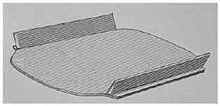John C. Babcock
John C. Babcock (born September 6, 1836 in Warwick , Rhode Island , † November 20, 1908 in Waterloo , Iowa ) was one of the founders of amateur rowing in the United States and an important intelligence officer of the Northern States in the American Civil War .
Life
When Babcock was nine years old, his parents moved him to Chicago . Here he worked after school for one of the city's largest architectural firms , specializing in the design and construction of mansions on Prairie Avenue . During the Civil War, he volunteered with the Sturgis Rifles in 1861, but was soon hired as a scout for the Army of the Potomac . Babcock was an expert in interrogating prisoners and began drawing exact maps in Allan Pinkerton's department for General George B. McClellan . His estimates of the number of enemies were exact. In 1862 he also officially joined Colonel George H. Sharpe's secret service . In 1863 it was Babcock, the gene. Robert E. Lee correctly anticipated movements through his maps for the aeronauts . In 1863 he helped at the Battle of Gettysburg . In the skirmish at Appomattox Court House in 1865, Babcock found General Lee under the apple tree, sealing the defeat of the southern states . Although he had no military rank, he was considered Colonel Babcock .
rowing
Babcock revolutionized rowing . In 1857 he and his friend William Buckingham Curtis founded the Metropolitan Rowing Club of Chicago , the first rowing club exclusively for amateurs and the first in what was then the West. In the summer of 1857 he invented the roller seat for the rowing boat and perfected it by 1870. In 1859 he won all rowing competitions with Curtis. In the winter of 1869/1870 he invented the first rowing ergometer for the hall. In 1872, Babcock wrote the statutes and became the founding president of the National Association of Amateur Oarsmen (NAAO), which later became the United States Rowing Association ( US Rowing ). Curtis and Babcock founded the New York Athletic Club (NYAC) with Harry Buermeyer in 1868. He became the first vice president and ensured the strict separation of professionals and amateurs.
Individual evidence
- ^ Edwin C. Fishel: The Secret War for the Union: The Untold Story of Military Intelligence in the Civil War . 1996, p. 258 (English).
- ^ Intelligence in the Civil War, by the CIA (p. 31). (PDF) (No longer available online.) Archived from the original on June 13, 2007 ; Retrieved December 26, 2016 .
- ↑ unknown author : unknown title . In: Waterloo Times Tribune . November 21, 1908.
- ^ Charles Edward Burrell: A history of Prince Edward County, Virginia: from its formation in 1753, to the present. 1922, accessed December 26, 2016 .
- ↑ unknown author : unknown title . In: New York Times Herald . February 18, 1890.
- ↑ Pembroke Rowing in the 1870s: The development of the "modern boat". (No longer available online.) In: www.usrowers.com. Archived from the original on March 4, 2016 ; Retrieved December 26, 2016 .
- ^ New York Facts and Figures. In: www.50states.com. Retrieved December 26, 2016 .
- ^ A Saga of a Philadelphia Rowing Club. In: pennac.org. Retrieved December 26, 2016 .
- ↑ Arnd Krüger : Whose Amateurism? The international standardization of the “amateur” in the later 19th and early 20th centuries . In: Angela Teja, Arnd Krüger & James Riordan (eds.): Sport e Culture - Sport and Cultures. Atti del IX Congreso internazionale dell 'European Committee for Sport History (CESH); Crotone, Italy; September 29, 2004 . Conference proceedings. Calopezzati 2005, ISBN 88-7862-003-3 , p. 294-307 (English).
| personal data | |
|---|---|
| SURNAME | Babcock, John C. |
| ALTERNATIVE NAMES | Babcock, Cal. |
| BRIEF DESCRIPTION | American rower, sports official, architect, civil war intelligence officer |
| DATE OF BIRTH | September 6, 1836 |
| PLACE OF BIRTH | Warwick , Rhode Island |
| DATE OF DEATH | November 20, 1908 |
| Place of death | Waterloo , Iowa |

